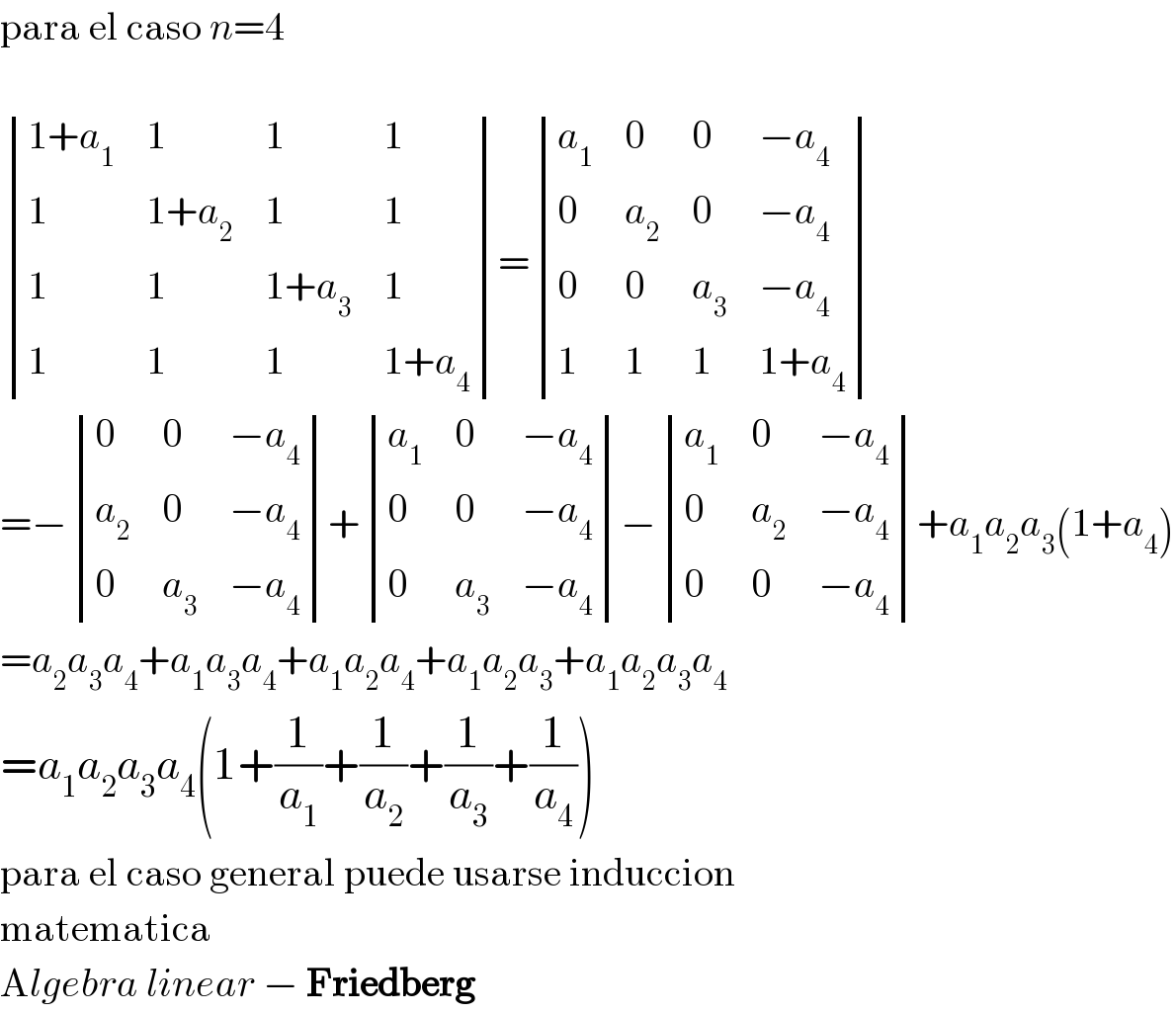
Previous in Matrices and Determinants Next in Matrices and Determinants
Question Number 84068 by Power last updated on 09/Mar/20

Commented by Power last updated on 09/Mar/20

$$\boldsymbol{\mathrm{prove}}\:\boldsymbol{\mathrm{it}}\:\boldsymbol{\mathrm{please}} \\ $$
Commented by Power last updated on 09/Mar/20

$$\boldsymbol{\mathrm{please}}\:\boldsymbol{\mathrm{see}} \\ $$
Commented by TANMAY PANACEA last updated on 09/Mar/20

Commented by arcana last updated on 20/Mar/20

$$\mathrm{para}\:\mathrm{el}\:\mathrm{caso}\:{n}=\mathrm{4} \\ $$$$ \\ $$$$\begin{vmatrix}{\mathrm{1}+{a}_{\mathrm{1}} }&{\mathrm{1}}&{\mathrm{1}}&{\mathrm{1}}\\{\mathrm{1}}&{\mathrm{1}+{a}_{\mathrm{2}} }&{\mathrm{1}}&{\mathrm{1}}\\{\mathrm{1}}&{\mathrm{1}}&{\mathrm{1}+{a}_{\mathrm{3}} }&{\mathrm{1}}\\{\mathrm{1}}&{\mathrm{1}}&{\mathrm{1}}&{\mathrm{1}+{a}_{\mathrm{4}} }\end{vmatrix}=\begin{vmatrix}{{a}_{\mathrm{1}} }&{\mathrm{0}}&{\mathrm{0}}&{−{a}_{\mathrm{4}} }\\{\mathrm{0}}&{{a}_{\mathrm{2}} }&{\mathrm{0}}&{−{a}_{\mathrm{4}} }\\{\mathrm{0}}&{\mathrm{0}}&{{a}_{\mathrm{3}} }&{−{a}_{\mathrm{4}} }\\{\mathrm{1}}&{\mathrm{1}}&{\mathrm{1}}&{\mathrm{1}+{a}_{\mathrm{4}} }\end{vmatrix} \\ $$$$=−\begin{vmatrix}{\mathrm{0}}&{\mathrm{0}}&{−{a}_{\mathrm{4}} }\\{{a}_{\mathrm{2}} }&{\mathrm{0}}&{−{a}_{\mathrm{4}} }\\{\mathrm{0}}&{{a}_{\mathrm{3}} }&{−{a}_{\mathrm{4}} }\end{vmatrix}+\begin{vmatrix}{{a}_{\mathrm{1}} }&{\mathrm{0}}&{−{a}_{\mathrm{4}} }\\{\mathrm{0}}&{\mathrm{0}}&{−{a}_{\mathrm{4}} }\\{\mathrm{0}}&{{a}_{\mathrm{3}} }&{−{a}_{\mathrm{4}} }\end{vmatrix}−\begin{vmatrix}{{a}_{\mathrm{1}} }&{\mathrm{0}}&{−{a}_{\mathrm{4}} }\\{\mathrm{0}}&{{a}_{\mathrm{2}} }&{−{a}_{\mathrm{4}} }\\{\mathrm{0}}&{\mathrm{0}}&{−{a}_{\mathrm{4}} }\end{vmatrix}+{a}_{\mathrm{1}} {a}_{\mathrm{2}} {a}_{\mathrm{3}} \left(\mathrm{1}+{a}_{\mathrm{4}} \right) \\ $$$$={a}_{\mathrm{2}} {a}_{\mathrm{3}} {a}_{\mathrm{4}} +{a}_{\mathrm{1}} {a}_{\mathrm{3}} {a}_{\mathrm{4}} +{a}_{\mathrm{1}} {a}_{\mathrm{2}} {a}_{\mathrm{4}} +{a}_{\mathrm{1}} {a}_{\mathrm{2}} {a}_{\mathrm{3}} +{a}_{\mathrm{1}} {a}_{\mathrm{2}} {a}_{\mathrm{3}} {a}_{\mathrm{4}} \\ $$$$={a}_{\mathrm{1}} {a}_{\mathrm{2}} {a}_{\mathrm{3}} {a}_{\mathrm{4}} \left(\mathrm{1}+\frac{\mathrm{1}}{{a}_{\mathrm{1}} }+\frac{\mathrm{1}}{{a}_{\mathrm{2}} }+\frac{\mathrm{1}}{{a}_{\mathrm{3}} }+\frac{\mathrm{1}}{{a}_{\mathrm{4}} }\right) \\ $$$$\mathrm{para}\:\mathrm{el}\:\mathrm{caso}\:\mathrm{general}\:\mathrm{puede}\:\mathrm{usarse}\:\mathrm{induccion} \\ $$$$\mathrm{matematica} \\ $$$$\mathrm{A}{lgebra}\:{linear}\:−\:\boldsymbol{\mathrm{Friedberg}} \\ $$
